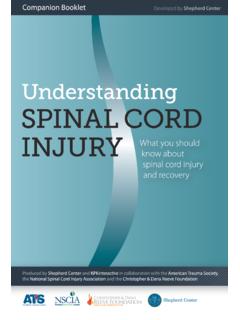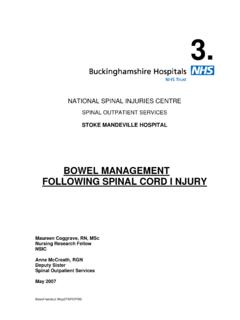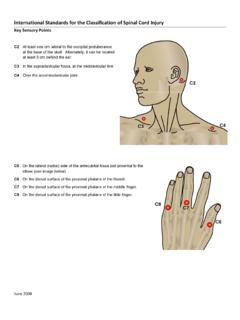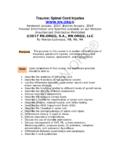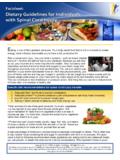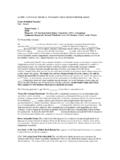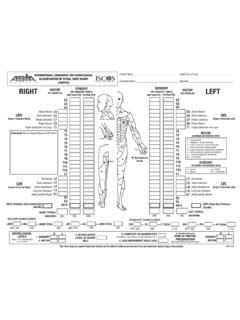Transcription of Manual for Use of Walking Index for Spinal Cord …
1 Instructions for the Use of the Walking Index for Spinal cord injury II (WISCI II) March 2005. Instructions for the Use of the Walking Index for Spinal cord injury II (WISCI II). (see attached scale and scoring sheet). The information in this Manual is based on current observations in clinical studies and recent publications1,2,,3,. This Manual will require ongoing modifications based on knowledge gained from future clinical trials as they occur. Subject Selection The purpose of this scale is for use in clinical trials to measure improvements in Walking in persons with Spinal cord injury .
2 The following outline describes subjects for whom the scale is most commonly utilized. 1. Spinal cord injury subjects who are capable of standing and Walking in the parallel bars will be eligible for assessment. Only a reciprocal gait is to be considered in scoring the WISCI scale. Additional inclusion/exclusion criteria may be necessary. 2. Most often ASIA A below T10 and ASIA B, C, and D subjects may qualify3. (Ditunno 2004). 3. Individuals with tetraplegia would require motor strength in triceps of at least grade 3 or be able to support their body weight3,4.
3 (Ditunno 2004, Dobkin 2003). Standardized Physical Environment and Distance This is a functional limitation scale, NOT a disability scale. It must be used in a standardized environment with standardized equipment and definitions, which are observed and recorded by professional staff that are trained. The following requirements are necessary: 1. A flat, smooth, non-slippery surface of 10 meters will be utilized. 2. Individuals walk at their own speed and the 10 meters should not be timed. Standardized Equipment 1.
4 Walkers should be conventional, but if a rolling walker is used, it should be coded as a walker and identified in the descriptors. 2. Use of a platform walker is equivalent to a walker. 3. Crutches can be Lofstrand (Canadian) or axillary. 4. Braces means one or two braces, either long or short, and should be identified in the descriptors. Other devices used for bracing such as ace wraps or splints should be coded as a brace and described under other . 5. Whether long leg braces are locked or unlocked at the knees should be identified in the descriptors.
5 6. Clothing should not cover braces to allow therapists and other professional staff to make a visual determination that the patient has a brace. Standardized Assistance 1. Any physical contact with the subject, including contact guard is considered physical assistance. 2. Supervision should not be regarded as physical assistance. Copy Freely Do Not Alter Copyright 2004. Thomas Jefferson University. All rights reserved Instructions for the Use of the Walking Index for Spinal cord injury II (WISCI II) March 2005.
6 Scoring (See attached scoring sheet). The Walking Index for Spinal cord injury Scale (WISCI 2) has demonstrated a response to change in the Spinal cord injury Locomotion Trial5 (ISCOS 2004) and in clinical validation studies1,6 (Ditunno 2003, 2004). In scoring the WISCI, check the descriptors that apply to current Walking performance, and then assign the highest level of Walking performance. In scoring one level, one should choose the level at which the patient is safe as judged by the therapist, with patient's comfort level described.
7 If devices other than those stated in the standard definitions are used, they should be documented as descriptors. If there is a discrepancy between two observers, the higher level should be chosen. The subject is observed by the trained personnel and the WISCI level is recorded on the scale of 0 to 20 at baseline (Baseline WISCI). The subject is observed again at the defined interval (Interval WISCI). The change in score is calculated by subtracting the baseline WISCI from the Interval WISCI, which equals the change in WISCI (Changed WISCI).
8 If a group of subjects are enrolled, medians and means may be calculated. References: 1. Ditunno JF, Ditunno PL, Graziani V, Scivoletto G, Bernardi M, Castellano V, Marchetti M, Brabeau H, Frankel HL, D'Andrea Greve JM, Ko HY, Marshall R, Nance P. Walking Index for Spinal cord injury (WISCI): an international multicenter validity and reliability study. Spinal cord 2000;38:234-243. 2. Ditunno PL, Ditunno JF. Walking Index for Spinal cord injury (WISCI II): scale revision. Spinal cord 2001;39:654-656.
9 3. Morganti B, Scivoletto G, Ditunno P, Ditunno JF, Molinari M. Walking Index for Spinal cord injury (WISCI): criterion validation. Spinal cord 2005; 43(1): 27-33. 4. Ditunno JF, West C, Schmidt M, Patrick M. Validation and refinement of the Walking Index for Spinal cord injury (WISCI) in a clinical setting. 30th Annual Scientific Meeting of the American Spinal injury Association, Denver, CO, May 14 . 16, 2004. 5. Doblin BH, Apple D, Barbeau H, Basso M, Behrman A, Deforge D, et el. Methods for a randomized trial of weight-supported treadmill training versus conventional training for Walking during inpatient rehabilitation after incomplete traumatic Spinal cord injury .
10 Neurorehabil Neural Repair 2003; 17(3):153-167. 6. Ditunno JF, Dobkin BH. Walking Index for Spinal cord injury (WISCI): response to change in a clinical trial (SCILT) and setting (TJU). Inaugural International Campaign for Cures of Spinal cord injury Paralysis (ICCP) Clinical Trials Workshop, Vancouver, Canada, February 20-21, 2004. 7. Ditunno JF, Jr., Burns AS, West C, Patrick M. Clinical validation of the Walking Index in Spinal cord injury (WISCI) scale: preliminary report. J Spinal cord Med 2003;26(Suppl 1):S37.
